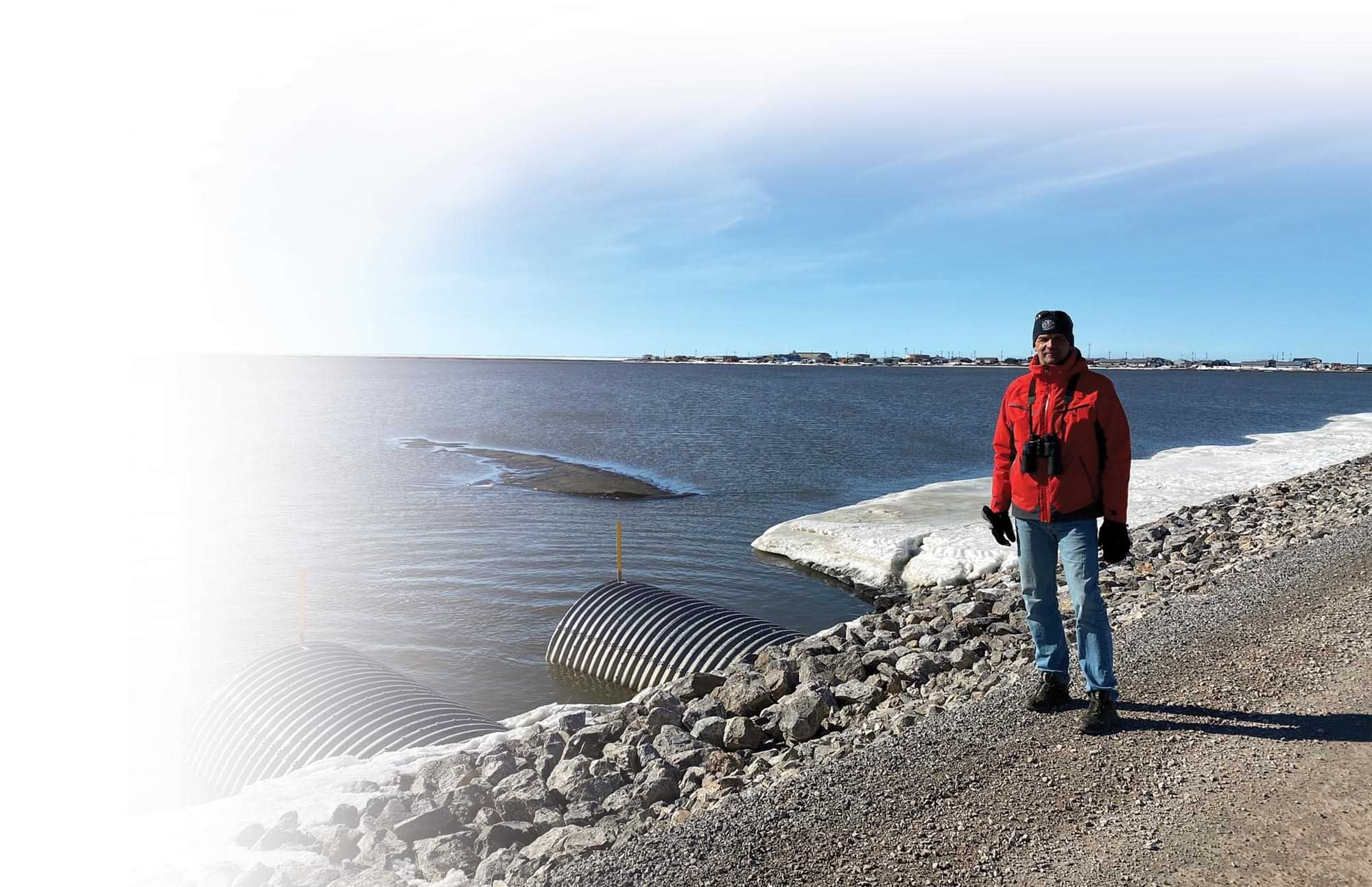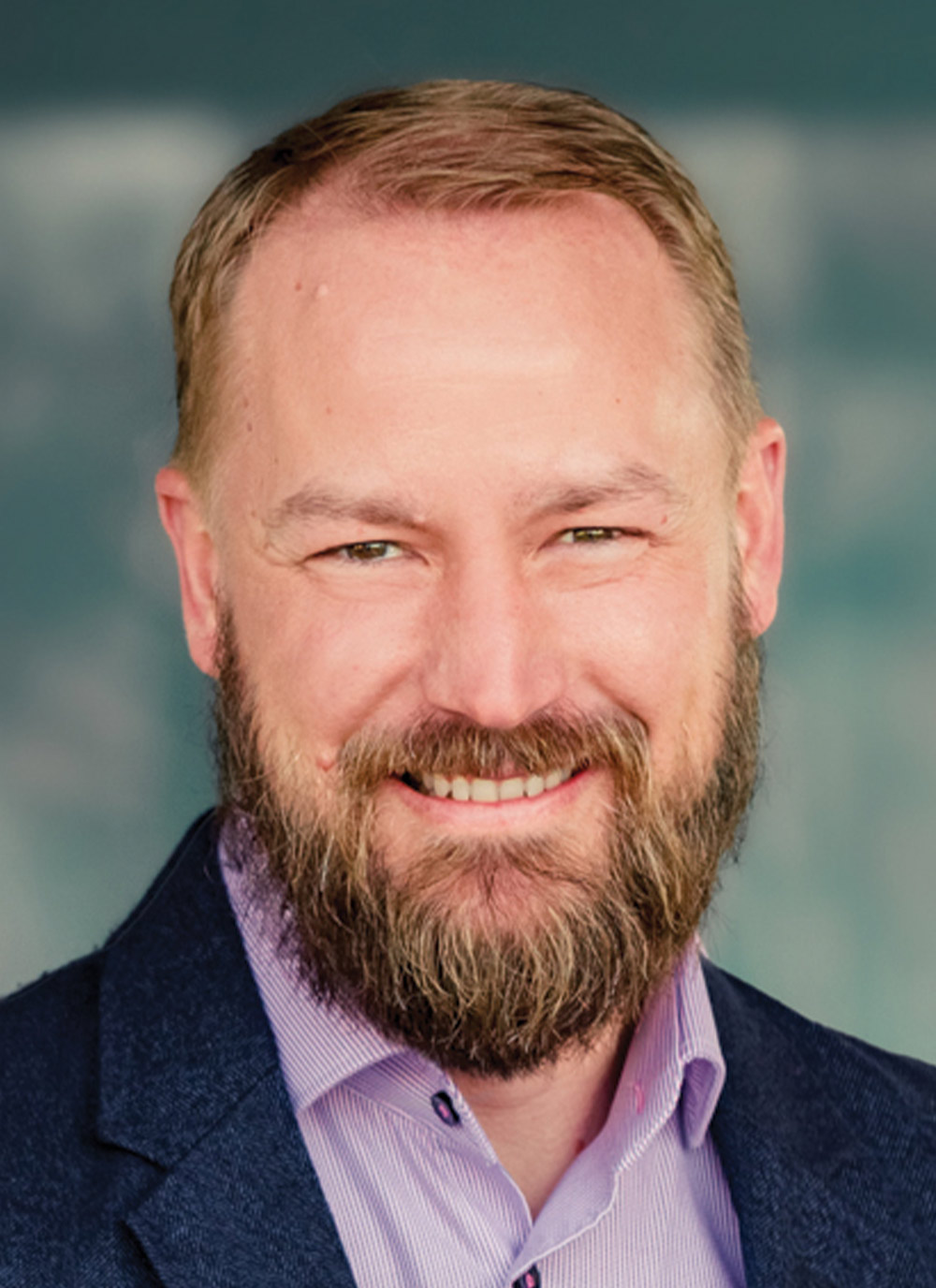Shoe Is
Dropping

he carbon-emissions problem has far-reaching ramifications, and it requires everyone working together to address the issue. Earth’s climate has always fluctuated, often driven by changes in the atmosphere, but changes observed in recent decades are faster and more extreme than at any recorded time. Human burning of fossil fuels has led to atmospheric greenhouse gas (GHG) concentrations not seen for millions of years, says Francis Wiese, science director of climate solutions at Stantec in Anchorage.
“These high concentrations have led to sharp increases in water and air temperatures across the globe, affecting our natural resources on land, rivers, lakes, and ocean,” he says. “This, in turn, is threatening food security, economic safety, and human well-being around the world. Because this is a global crisis, no one person, company, or country can solve this alone; only working together, and everyone doing what they can at all levels simultaneously to reduce their carbon footprint, do we stand a chance to eventually reverse the effects of climate change.”
The term “carbon footprint” refers to the amount of GHG emissions—primarily carbon dioxide—emitted due to the actions and choices of an individual, organization, or nation. Human activities are responsible for almost all the GHG increase in the last 150 years, according to the US Environmental Protection Agency (EPA). The largest source of GHG emissions in the United States is from burning fossil fuels for electricity, heat, and transportation. Carbon dioxide, CO2, accounts for about 80 percent of GHG emissions, with methane, nitrous oxide, and fluorinated gasses contributing the rest. By economic sector, the primary GHG generators are transportation at 27 percent; electricity at 25 percent; industry at 24 percent; commercial and residential at 13 percent; and agriculture at 11 percent, based on the EPA’s 2022 Inventory of US Greenhouse Gas Emissions and Sinks: 1990-2020.
Freeman worked at Coffman as a young engineer, and this summer the firm brought him back to lead efforts to reduce GHG emissions beyond solutions like renewable electricity. Coffman strives to serve as a “thought partner” for companies that want to understand options to decarbonize their business. “People are becoming more familiar with solar, wind, and battery storage, but there are other things like hydrogen and carbon capture,” Freeman explains. “Those are all levers that companies can use to decarbonize their operations and grow their business.”
Coffman, with offices in Anchorage and nationwide, offers a full suite of tools to help clients decarbonize. “Whether it’s hospitals, utilities, or building owners, we can help those clients figure out the most cost-effective way to run their business sustainably while doing it in a low-carbon way,” Freeman says.
Stantec, an international firm that focuses on sustainable design and engineering, provides climate solutions to clients worldwide and from offices in Anchorage, Fairbanks, and Wasilla. Its offerings include climate advisory services to determine what companies need to worry about most; resilient adaption services, which includes both nature-based and engineered solutions; and GHG emissions mitigation solutions, including those related to their buildings, transportation, resource use, products, and supply chain.
Evaluating Carbon Emissions
Scope 1 emissions are direct emissions from company-owned and controlled resources. Scope 2 emissions are indirect emissions from the generation of purchased energy, from a utility provider. And Scope 3 emissions are all indirect emissions—not included in scope 2—that occur in the value chain of the reporting company, including both upstream and downstream emissions. Scope 3 emissions, which are separated into fifteen different categories according to GHG protocol, relate to certain activities linked to a company’s operations.
The crux of the matter, Freeman says, is this: “Do you understand the carbon intensity of your business, and where those emissions are happening in the value chain?”

Francis Wiese
Stantec
The recently passed Inflation Reduction Act of 2022 is, in part, designed to entice more businesses to focus on minimizing their carbon footprint. The new law promotes the widespread deployment of carbon removal technologies through incentives. “You can generate tax credits with hydrogen production to decarbonize emissions,” Freeman explains, “but those are government incentives, and they are not sustainable long term. Eventually, we’ll need market-based incentives to achieve the right solutions.” Short term, though, Freeman says the new incentives will advance domestic carbon capture and hydrogen.
Ultimately, companies need to comprehend their potential for an economic return as they consider various emissions-lowering opportunities. “There may be some things that make economic sense today while other opportunities require a regulatory framework that values lower-carbon businesses, creates a level playing field, and lets the market drive those innovations to get the world to net zero,” Freeman says.
Making Sense Today
Businesses can electrify their fuel use by leveraging renewables and battery storage. They can also capitalize on opportunities involving carbon capture, carbon offsets, and carbon credits to avoid and/or decrease carbon emissions.
From Wiese’s point of view, there is no one-size-fits-all approach to cutting carbon emissions. Specific solutions depend on the type of operation, but general strategies can include energy efficiency; switching to renewable energy; increasing sustainability practices, such as recycling or reducing water use; reducing travel; shortening supply chains; and implementing or supporting nature-based carbon solutions to increase carbon sequestration.
Whether the “S” stands for sequestration or storage, CCUS involves trapping CO2 from combustion exhaust and either reusing or storing the waste so it will not enter the atmosphere. “You can do this on site where the emissions are taking place and take advantage of existing infrastructure,” Wiese explains, “so for oil and gas operations, for example, you can capture and reinject your emissions into the well, reducing your net emissions that way.” That scenario, Wiese says, is the most obvious of the very few where CCUS currently makes financial and environmental sense.
In most cases, though, CCUS solutions to date do not scale well enough to make a difference, and engineered carbon capture solutions are expensive, Wiese points out. “If companies are interested in supporting carbon capture and sequestration, they are much better off investing in nature-based carbon solutions, such as ecosystem restoration,” he says. “Ecosystem restoration has the added benefit of also supporting biodiversity, water and air quality, ecosystem resilience, and human well-being—all in one go. At Stantec, we promote that solution to clients across all sectors, and it has been very effective.”

Coffman Engineers
Shoreline erosion on the Noatak River near the village of Noatak. Erosion to the river is threatening the Noatak Airport runway and has forced the relocation of the cemetery, sewage lagoon, and an access road.
Stantec
Stantec

One carbon emission source that sets Alaska apart from other states is reliance on aircraft. In addition to intrastate travel through general aviation, a typical Alaskan can only leave the state using jetliners. The UN International Civil Aviation Organization’s online emissions calculator estimates more than 800 pounds of CO2 are emitted per passenger during a typical round-trip flight between Anchorage and Seattle. That’s about the same as generating 1 MWh of electricity, as much as an average American uses in three months.
Conscious of this impact, Alaska Airlines is making carbon-cutting choices today. The company recently launched a program to advance sustainable aviation fuels (SAF), which uses waste oils or vegetable oils to reduce reliance on petroleum. Blended fuels have been demonstrated on commercial airliners, and full adoption depends on a robust supply chain at a price point that won’t cut into profits. Alaska Airlines also committed last year to net zero carbon emissions by 2040, with shorter-term goals by 2025 to improve its impact relative to carbon, waste, and water.
“We are all in this together,” Wiese says, “so every bit really counts and is needed to achieve our local, regional, national, and global emission goals to help safeguard environmental and human well-being.” Those bits include climate adaptation and mitigation alongside sustainability, based on choices made at the government, business, and personal levels.
Wiese believes businesses across Alaska play a key role in the path forward, as they generally plan long term and look beyond political agendas. “Businesses can be leaders of this change,” he says. “They can support the inclusion of all voices and knowledge systems, such as Indigenous knowledge that is so rich and important in our state and elsewhere, and support public-private partnerships to accelerate the technological innovations we still need.” ![]()
To read another article by this author, choose this article.